文章目录
- 分配器
- c++中的new和delete
- 1、new operator
- 2、operator new
- 3、placement new
- 实际测试
- delete
- STL分配器
- 基本的构造和析构工具
- construct
- delete
- allocate
- 一级配置器
- 二级配置器
- MyTinySTL分配器
- construct
- destroy
- allocate
分配器
c++中的new和delete
1、new operator
new operator就是new操作符,平时使用的new(如int *pt = new object(...);)主要完成两个工作:
- 分配足够的内存以便容纳所需类型的对象(operator new)
- 调用构造函数初始化内存中的对象(placement new)
2、operator new
new操作符为分配内存所调用函数的名字是operator new,就是间接性的调用了 malloc函数。
源码:
void* __CRTDECL operator new(size_t const size)
{
for (;;)
{
if (void* const block = malloc(size))
{
return block;
}
if (_callnewh(size) == 0)
{
if (size == SIZE_MAX)
{
__scrt_throw_std_bad_array_new_length();
}
else
{
__scrt_throw_std_bad_alloc();
}
}
}
}
3、placement new
placement new用来在已经申请的内存上构建对象,其实不只是堆, 连栈上也能构建对象,这也是内存池经常用的方法。
尝试一波:
#include <iostream>
class test
{
private:
int one;
public:
test():one(9) {}
};
int main()
{
char buffer[4] = { 0 };
test *pt = new(buffer) test;
system("pause");
return 0;
}
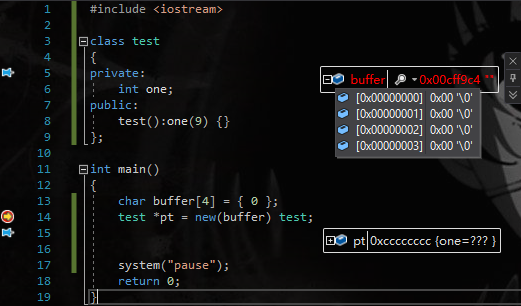
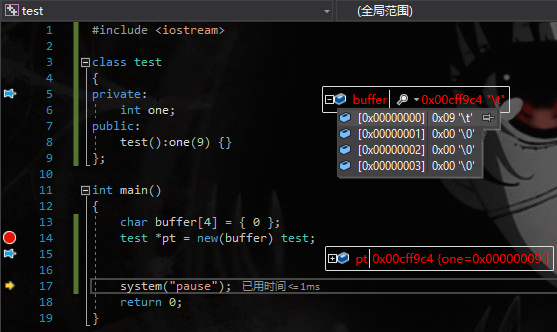
实际测试
#include <iostream>
class test
{
private:
int one;
public:
test():one(9) {}
};
int main()
{
test *pt1 = new test;
test *pt2 = (test*)operator new(sizeof(test));
test *pt3 = new(pt2) test;
system("pause");
return 0;
}
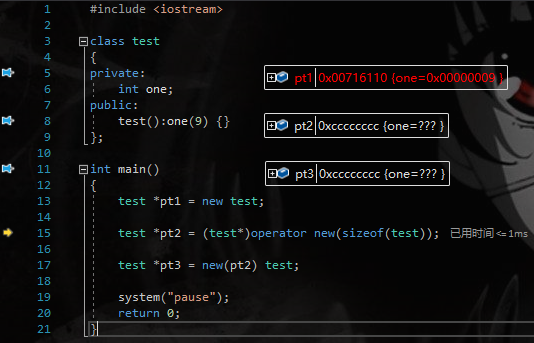
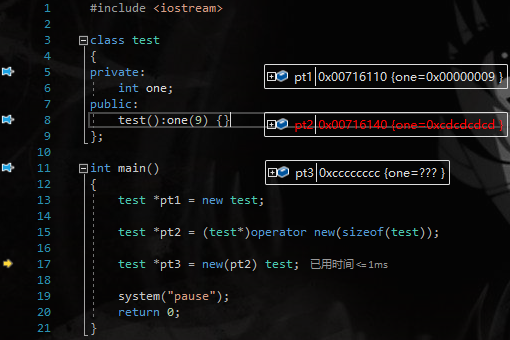

可以看见pt1(new operator)的效果就是pt2(operator new)+pt3(placement new)。
delete
delete的实现也是跟new有很多相似的, delete事先调用析构函数, 然后再调用free函数释放内存, 同样是可以将析构和释放内存分开调用, 也可以进行重载。
STL分配器
分配器将new的申请空间(allocate)和调用构造函数(construct)的两个功能分开实现。
基本的构造和析构工具
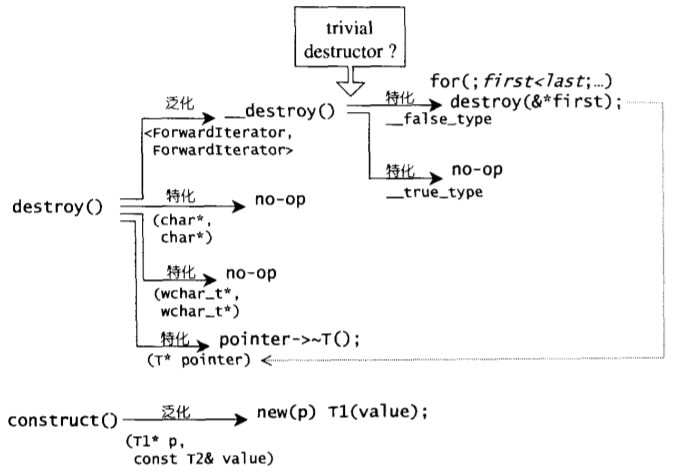
construct
template <class T1, class T2>
inline void construct(T1* p, const T2& value)
{
new (p) T1(value);
}
construct调用的是placement new, 在一个已经获得的内存里建立一个对象。
delete
destroy调用析构函数并且有两个版本
版本一传入指针直接就调用了析构函数:
template <class T> inline void destroy(T* pointer)
{
pointer->~T();
}
版本二需要传入两个迭代器,并且根据是否有自定义的析构函数来执行析构:
// 接受两个迭代器, 并设法找出元素的类型。
template <class ForwardIterator>
inline void destroy(ForwardIterator first, ForwardIterator last)
{
__destroy(first, last, value_type(first));
}
template <class ForwardIterator, class T>
inline void __destroy(ForwardIterator first, ForwardIterator last, T*)
{
// 分析是否有traival destructor(系统自带的析构函数)。
typedef typename __type_traits<T>::has_trivial_destructor trivial_destructor;
__destroy_aux(first, last, trivial_destructor());
}
这是我们后面经常能看到的情况,根据对类的信息的判断做出相应的处理。
// 当__type_traits为__false_type时,通过迭代所有的对象并调用版本一的函数执行析构函数进行析构。
template <class ForwardIterator>
inline void __destroy_aux(ForwardIterator first, ForwardIterator last, __false_type)
{
for ( ; first < last; ++first)
destroy(&*first);
}
// 当__type_traits为__true_type时, 什么也不做, 因为这样效率很高效, 并不需要执行析构函数。
template <class ForwardIterator>
inline void __destroy_aux(ForwardIterator, ForwardIterator, __true_type) {}
// 对字符指针的特化版本
inline void destory(char*, char*) {}
inline void destory(wchar_t*, wchar_t*) {}
allocate
allocate申请内存是有分为一级配置器(__malloc_alloc_template )和二级配置器(__default_alloc_template), 分配的空间小于128字节的就调用二级配置器, 大于就直接使用一级配置器, 一级配置器直接调用malloc申请, 二级使用内存池。
SGI包装的接口(不管是一级配置器还是二级配置器都是使用这个接口进行分配的,四个成员都是单纯干掉转调用):
template<class T, class Alloc>
class simple_alloc
{
public:
static T *allocate(size_t n)
{ return 0 == n? 0 : (T*) Alloc::allocate(n * sizeof (T)); }
static T *allocate(void)
{ return (T*) Alloc::allocate(sizeof (T)); }
static void deallocate(T *p, size_t n)
{ if (0 != n) Alloc::deallocate(p, n * sizeof (T)); }
static void deallocate(T *p)
{ Alloc::deallocate(p, sizeof (T)); }
};
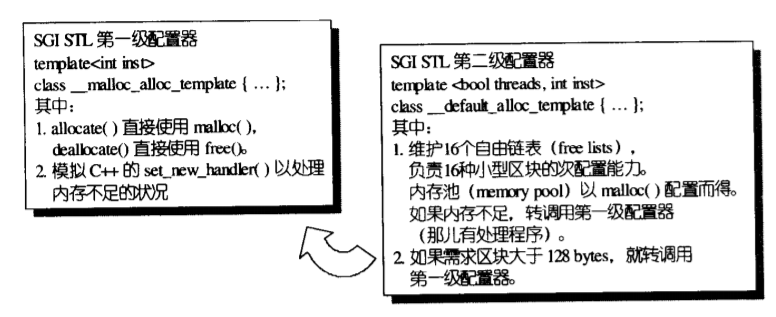
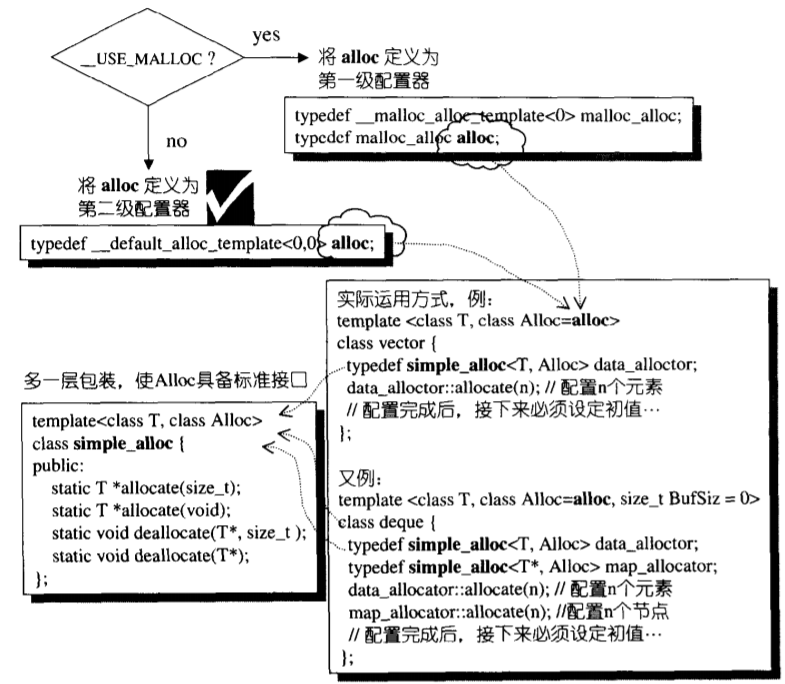
一级配置器
一级配置器只是封装了malloc、free、realloc等c函数来进行内存的配置,并且在内存分配异常的时候可以执行用户指定的函数。
// 一级配置器
// inst完全没派上用场
template <int inst>
class __malloc_alloc_template
{
// 这里private里面的函数都是在内存不足的时候进行调用的
private:
static void *oom_malloc(size_t); // 分配不足
static void *oom_realloc(void *, size_t); // 重新分配不足
#ifndef __STL_STATIC_TEMPLATE_MEMBER_BUG
static void (* __malloc_alloc_oom_handler)(); // 内存不足设置的处理例程, 默认设置的是0, 表示没有设置处理例程, 这个处理例程是由用户手动设置的
#endif
public:
static void * allocate(size_t n)
{
void *result = malloc(n); // 一级配置器直接使用malloc
if (0 == result) result = oom_malloc(n); // 当内存不足的时候调用oom_malloc
return result;
}
static void deallocate(void *p, size_t /* n */)
{
free(p); // 一级配置器直接使用free
}
static void * reallocate(void *p, size_t /* old_sz */, size_t new_sz)
{
void * result = realloc(p, new_sz); // 一级配置器直接使用realloc
if (0 == result) result = oom_realloc(p, new_sz); // 当内存不足的时候调用oom_realloc
return result;
}
// 这里是模仿c++的set_new_handler. 是由用户自己定义的处理函数, 没有设置默认为0
static void (* set_malloc_handler(void (*f)()))()
{
void (* old)() = __malloc_alloc_oom_handler;
__malloc_alloc_oom_handler = f;
return(old);
}
}
// 默认将处理例程设置为0, 只有用户自己设置
template <int inst>
void (* __malloc_alloc_template<inst>::__malloc_alloc_oom_handler)() = 0;
template <int inst>
void * __malloc_alloc_template<inst>::oom_malloc(size_t n)
{
void (* my_malloc_handler)();
void *result;
// 不断尝试释放 配置内存
for (;;)
{
my_malloc_handler = __malloc_alloc_oom_handler;
if (0 == my_malloc_handler) { __THROW_BAD_ALLOC; }
(*my_malloc_handler)(); // 调用处理例程 企图释放内存
result = malloc(n); // 再次尝试配置内存
if (result) return(result);
}
}
template <int inst>
void * __malloc_alloc_template<inst>::oom_realloc(void *p, size_t n)
{
void (* my_malloc_handler)();
void *result;
// 不断尝试释放 配置内存
for (;;) {
my_malloc_handler = __malloc_alloc_oom_handler;
if (0 == my_malloc_handler) { __THROW_BAD_ALLOC; }
(*my_malloc_handler)(); // 调用处理例程 企图释放内存
result = realloc(p, n); // 再次尝试配置内存
if (result) return(result);
}
}
// 默认将malloc_alloc设为0
typedef __malloc_alloc_template<0> malloc_alloc;
二级配置器
因为比较小的内存会带来内存碎片等问题,并且也是一个内存负担。
二级配置器在分配超过128字节大小内存的时候使用一级配置器,否则使用内存池进行管理。
内存池管理又称为层次配置:每次配置一大块内存,并维护对应的16个空闲链表(free-list)。下次若有相同大小的内存需求,则直接从free-list中取。如果有小额区块被释放,则由配置器回收到free-list中。16个空闲链表分别管理大小为8、16、24…120、128的数据块(为8的倍数方便管理)。
通过图片看一下:
-
下面是空闲链表中管理8byte的,链接了3块可用的内存,三个use的内存已经分给用户了,不归空闲链表管,其他空白区域就是未分配的内存。
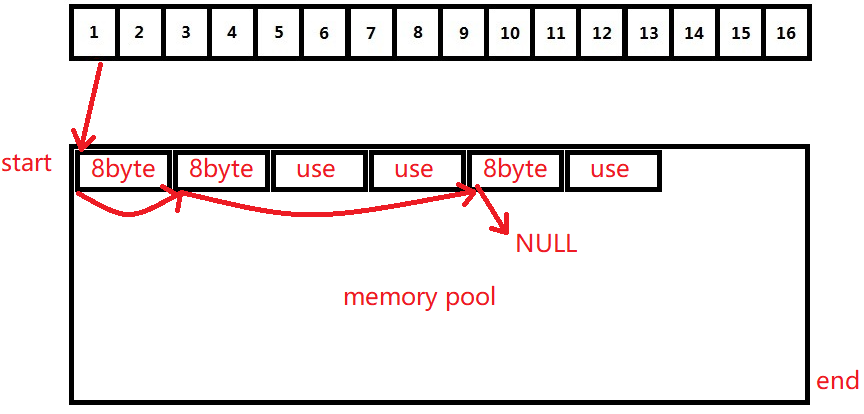
-
分配出去一个8byte的内存

-
回收中间16byte
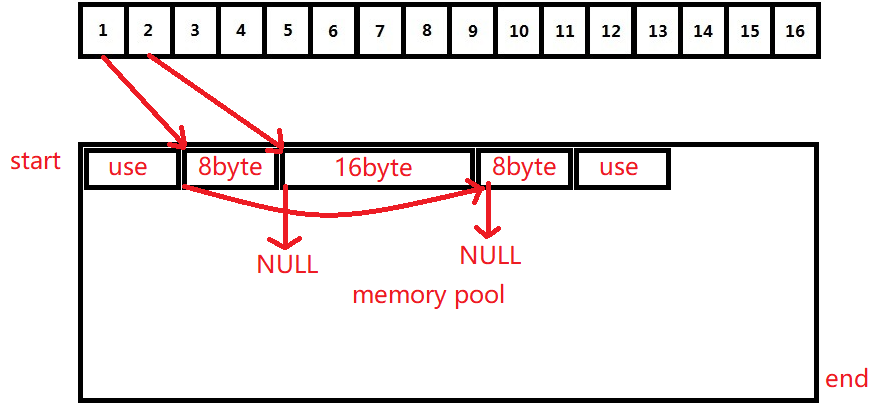
enum {__ALIGN = 8}; // 设置对齐要求. 对齐为8字节, 没有8字节自动补齐
enum {__MAX_BYTES = 128}; // 第二级配置器的最大一次性申请大小, 大于128就直接调用第一级配置器
enum {__NFREELISTS = __MAX_BYTES/__ALIGN}; // 链表个数, 分别代表8, 16, 32....字节的链表
// 二级配置器
// threads用于多线程情况下不做讨论
// inst完全没派上用场
template <bool threads, int inst>
class __default_alloc_template
{
private:
// 将bytes上调到8的倍数
static size_t ROUND_UP(size_t bytes)
{
return (((bytes) + ALIGN-1) & ~(__ALIGN - 1));
}
union obj
{
union obj* free_list_link; // 指向下一个区块
char client_data[1]; // 储存本块内存的首地址
}
// 16个freelist
static obj * volatile free_list[__NFREELISTS];
// 根据区块的大小决定使用第n个freelist n从1开始算起
static size_t FREELIST_INDEX(size_t bytes)
{
return (((bytes) + ALIGN-1) / __ALIGN - 1);
}
static void* refill(size_t n);
static char* chunk_alloc(size_t size, int& nobjs);
char *start_free; // 内存池的首地址
char *end_free; // 内存池的结束地址
size_t heap_size; // 多次调用内存池, 就会更多的是给链表分配内存, 这就是一个增量.
public:
static void * allocate(size_t n);
static void deallocate(void *p, size_t n);
static void * reallocate(void *p, size_t old_sz, size_t new_sz);
};
template <bool threads, int inst>
char *__default_alloc_template<threads, inst>::start_free = 0;
template <bool threads, int inst>
char *__default_alloc_template<threads, inst>::end_free = 0;
template <bool threads, int inst>
size_t __default_alloc_template<threads, inst>::heap_size = 0;
template <bool threads, int inst>
size_t __default_alloc_template<threads, inst>::obj * volatile size_t __default_alloc_template<threads, inst>::free_list[__NFREELISTS] = {0, 0, 0, 0, 0, 0, 0, 0, 0, 0, 0, 0, 0, 0, 0, 0};
空间配置函数allocate检查对应的空闲链表,如果该空闲链表中有可用数据块,则直接拿来用(拿取空闲链表中的第一个可用数据块,然后把该空闲链表的地址设置为该数据块指向的下一个地址),如果没有可用数据块,则调用refill重新填充空间。
static void * allocate(size_t n)
{
obj * __VOLATILE * my_free_list;
obj * __RESTRICT result;
// 先判断申请的字节大小是不是大于128字节, 是则交给第一级配置器来处理. 否则继续往下执行
if (n > (size_t) __MAX_BYTES)
{
return(malloc_alloc::allocate(n));
}
// 找到分配的地址对齐后分配的是第几个大小的链表 获得该链表指向的首地址
my_free_list = free_list + FREELIST_INDEX(n);
result = *my_free_list;
if (result == 0) // 没有多余的内存, 就先填充链表.
{
void *r = refill(ROUND_UP(n));
return r;
}
// 返回链表的首地址, 和一块能容纳一个对象的内存, 并更新链表的首地址
*my_free_list = result -> free_list_link;
return (result);
};
空间释放函数deallocate根据数据块的大小来判断回收后的空间会被插入到哪个空闲链表。
static void deallocate(void *p, size_t n)
{
obj *q = (obj *)p;
obj * __VOLATILE * my_free_list;
// 释放的内存大于128字节直接调用一级配置器进行释放
if (n > (size_t) __MAX_BYTES)
{
malloc_alloc::deallocate(p, n);
return;
}
// 将内存直接还给对应大小的链表就行了, 并不用直接释放内存, 以便后面分配内存的时候使用
my_free_list = free_list + FREELIST_INDEX(n);
q -> free_list_link = *my_free_list;
*my_free_list = q;
}
如果空闲链表中没有可用数据块,就会调用refill来重新填充空间,新的空间取自内存池。缺省取20个数据块,如果内存池空间不足,那么能取多少个节点就取多少个。
template <bool threads, int inst>
void* __default_alloc_template<threads, inst>::refill(size_t n)
{
int nobjs = 20;
char * chunk = chunk_alloc(n, nobjs); // 向内存池申请空间的起始地址 nobjs为引用
obj * __VOLATILE * my_free_list;
obj * result;
obj * current_obj, * next_obj;
int i;
// 如果只申请到一个对象的大小, 就直接返回一个内存的大小
if (1 == nobjs) return(chunk);
my_free_list = free_list + FREELIST_INDEX(n);
// 申请的大小不止一个对象的大小的时候
result = (obj *)chunk;
// my_free_list指向内存池返回的地址的下一个对齐后的地址
*my_free_list = next_obj = (obj *)(chunk + n);
// 这里从第二个开始的原因主要是第一块地址返回给了用户, 现在需要把从内存池里面分配的内存用链表给串起来
for (i = 1; ; i++)
{
current_obj = next_obj;
next_obj = (obj *)((char *)next_obj + n);
if (nobjs - 1 == i)
{
current_obj -> free_list_link = 0;
break;
}
else
{
current_obj -> free_list_link = next_obj;
}
}
return(result);
}
从内存池取空间给空闲链表,首先根据end_free-start_free来判断内存池中的剩余空间是否足以调出nobjs个大小为size的数据块出去,如果内存连一个数据块的空间都无法供应,需要用malloc取堆中申请内存。
template <bool threads, int inst>
char* __default_alloc_template<threads, inst>::chunk_alloc(size_t size, int& nobjs)
{
char * result;
size_t total_bytes = size * nobjs; // 链表需要申请的内存大小
size_t bytes_left = end_free - start_free; // 内存池里面总共还有多少内存空间
if (bytes_left >= total_bytes) // 内存池的大小大于需要的空间, 直接返回起始地址
{
result = start_free;
start_free += total_bytes; // 内存池的首地址往后移
return(result);
}
else if (bytes_left >= size) // 内存池的内存不足以马上分配那么多内存, 但是还能满足分配一个即以上的大小, 那就按对齐方式全部分配出去
{
nobjs = bytes_left/size;
total_bytes = size * nobjs;
result = start_free;
start_free += total_bytes; // 内存池的首地址往后移
return(result);
}
else // 如果一个对象的大小都已经提供不了了, 那就准备调用malloc申请两倍+额外大小的内存
{
size_t bytes_to_get = 2 * total_bytes + ROUND_UP(heap_size >> 4);
// 内存池还剩下的零头内存分给给其他能利用的链表, 也就是绝不浪费一点.
if (bytes_left > 0)
{
// 寻找合适的freelist加入其中
obj * __VOLATILE * my_free_list = free_list + FREELIST_INDEX(bytes_left);
((obj *)start_free) -> free_list_link = *my_free_list;
*my_free_list = (obj *)start_free;
}
// 申请空间
start_free = (char *)malloc(bytes_to_get);
// 内存不足了
if (0 == start_free)
{
int i;
obj * __VOLATILE * my_free_list, *p;
// 充分利用剩余链表的内存, 通过递归来申请
for (i = size; i <= __MAX_BYTES; i += __ALIGN)
{
my_free_list = free_list + FREELIST_INDEX(i);
p = *my_free_list;
if (0 != p)
{
// 找到未使用的区块 递归分配
*my_free_list = p -> free_list_link;
start_free = (char *)p;
end_free = start_free + i;
return(chunk_alloc(size, nobjs));
}
}
// 如果一点内存都没有了的话, 就只有调用一级配置器来申请内存了, 并且用户没有设置处理例程就抛出异常
end_free = 0;
start_free = (char *)malloc_alloc::allocate(bytes_to_get);
}
// 申请内存成功后重新修改内存起始地址和结束地址, 重新调用chunk_alloc分配内存
heap_size += bytes_to_get;
end_free = start_free + bytes_to_get;
return(chunk_alloc(size, nobjs));
}
}
MyTinySTL分配器
涉及到的文件construct.h、allocator.h。
这边配置器取消掉了内存池,所以看起来就非常简单了。
有一些traits萃取剂相关内容会在迭代器中详细解释。
construct
构造直接调用了placement new
template <class Ty>
void construct(Ty* ptr)
{
::new ((void*)ptr) Ty();
}
template <class Ty1, class Ty2>
void construct(Ty1* ptr, const Ty2& value)
{
::new ((void*)ptr) Ty1(value);
}
template <class Ty, class... Args>
void construct(Ty* ptr, Args&&... args)
{
::new ((void*)ptr) Ty(mystl::forward<Args>(args)...);
}
destroy
析构单个对象,这边调用了std::is_trivially_destructible用来判断是否有系统默认的析构函数,如果是系统默认的析构函数就没有必要执行。
template <class Ty>
void destroy(Ty* pointer)
{
destroy_one(pointer, std::is_trivially_destructible<Ty>{});
}
/*! 普通可破坏类型 */
template <class Ty>
void destroy_one(Ty*, std::true_type) {}
/*! 有自定义的析构函数 */
template <class Ty>
void destroy_one(Ty* pointer, std::false_type)
{
if (pointer != nullptr)
{
pointer->~Ty();
}
}
析构两个迭代器之间全部对象
template <class ForwardIter>
void destroy(ForwardIter first, ForwardIter last)
{
// 按照迭代器种类分类处理
destroy_cat(first, last, std::is_trivially_destructible<typename iterator_traits<ForwardIter>::value_type>{});
}
/*! 普通可破坏类型 */
template <class ForwardIter>
void destroy_cat(ForwardIter, ForwardIter, std::true_type) {}
/*! 有自定义的析构函数 */
template <class ForwardIter>
void destroy_cat(ForwardIter first, ForwardIter last, std::false_type)
{
for (; first != last; ++first)
{
destroy(&*first);
}
}
allocate
分配器管理内存的分配、释放,对象的构造、析构,并且也知道数据的类型。
template <class T>
class allocator
{
public:
typedef T value_type; /*! 数据类型 */
typedef T* pointer; /*! 数据类型指针 */
typedef const T* const_pointer; /*! const数据类型指针 */
typedef T& reference; /*! 数据类型引用 */
typedef const T& const_reference; /*! const数据类型引用 */
typedef size_t size_type; /*! 数据类型大小 */
typedef ptrdiff_t difference_type; /*! 数据类型指针距离 */
public:
// 分配内存
static T* allocate();
static T* allocate(size_type n);
// 回收内存
static void deallocate(T* ptr);
static void deallocate(T* ptr, size_type n);
// 构造对象
static void construct(T* ptr);
static void construct(T* ptr, const T& value);
static void construct(T* ptr, T&& value);
template <class... Args>
static void construct(T* ptr, Args&& ...args);
// 析构对象
static void destroy(T* ptr);
static void destroy(T* first, T* last);
};
分配内存直接使用的operator new
template <class T>
T* allocator<T>::allocate()
{
return static_cast<T*>(::operator new(sizeof(T)));
}
template <class T>
T* allocator<T>::allocate(size_type n)
{
if (n == 0)
{
return nullptr;
}
return static_cast<T*>(::operator new(n * sizeof(T)));
}
回收内存使用的operator delete
template <class T>
void allocator<T>::deallocate(T* ptr)
{
if (ptr == nullptr)
{
return;
}
::operator delete(ptr);
}
template <class T>
void allocator<T>::deallocate(T* ptr, size_type /*size*/)
{
if (ptr == nullptr)
{
return;
}
::operator delete(ptr);
}
构造和析构对象直接调用的上面的construct和destroy,代码就不贴了。
最后
以上就是怕黑黄蜂最近收集整理的关于MyTinySTL阅读笔记---分配器分配器MyTinySTL分配器的全部内容,更多相关MyTinySTL阅读笔记---分配器分配器MyTinySTL分配器内容请搜索靠谱客的其他文章。








发表评论 取消回复